The Biggest Sucker
So, do you want to suck big time? What I mean is, do you want to be a black hole? You’re in luck, because this guide will teach you some of the basic tricks on how to be one of the biggest suckers in the universe!
But before we turn our attention to actually becoming a black hole, let us first start with the fundamentals. Let’s begin by talking about what two blokes named Newton and Einstein said about this thing called ‘gravity’.
Why I Am Attracted To You
Legend tells us that a fellow named Isaac Newton was inspired to formulate his theory of gravity when he saw an apple falling (not very far) from the tree. The truth of this story is not that important; what’s important is that Newton’s supposed observation made him realize that the same force that made the apple fall towards the ground also made the Moon go around the Earth! In fact, this is the same force that keeps the planets in orbit around the Sun, and that keeps the Sun and all the other stars of the Milky Way Galaxy in orbit around the galactic center (which is probably home to a gigantic black hole, but let’s not get ahead of ourselves).
As a matter of fact, Newton said that everything in the universe that has mass pulls towards it every other thing that has mass. In short, everything with mass attracts everything else with mass! This means that I am attracted to you, gravitationally speaking. After all, you and I both have mass. And yes, you are attracted to me too (gravitationally, of course, and perhaps otherwise). And yes, there’s also mutual (gravitational) attraction between myself and this nearby bottle of wine, and between myself and the binary star Sirius 8.3 light years away.

Yes, I know, Newton’s idea sounds loony, to say the least. But, like most crazy-sounding ideas in physics, it comes with an equation that has proven effective for centuries. This equation is:
F = (G *mA*mB)÷d2
Here, F stands for the strength of the gravitational attraction between two objects A and B. On the other side of the equation, mA stands for the mass of A while mB stands for the mass of B; d stands for the distance between A and B and, finally, G is a number called the universal gravitational constant. We’ll get back to G later. For now, what’s important is that the equation above was proven true for hundreds of years after Newton wrote it down. More importantly, Newton’s simple equation explained so many different things, like why gravity is weaker on the Moon than on Earth, why the planets move around the Sun in elliptical orbits, and why angry birds shot from a sling follow a parabolic path.
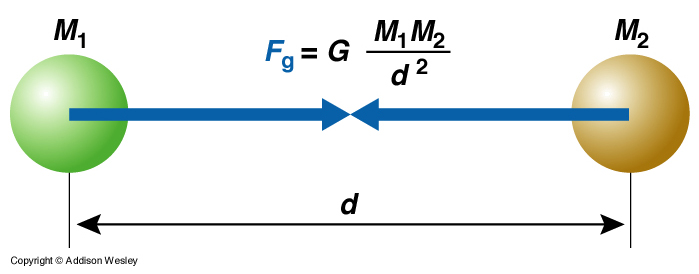
But then the question arises: why don’t we feel our mutual (gravitational) attraction? If you have mass and I have mass and what Newton said is true, then where’s the love? The explanation lies with the number G in the equation above. The thing about G is that it’s a pretty small number. As a matter of fact, it is given by
G = 0.00000000006673 N m2/kg2,
which is miniscule indeed. Because G is so small, the strength of gravitational attraction between everyday things and between ordinary people (i.e. people aside from yo mama) is negligible. Let me give a specific example to illustrate this point. Say, person A has a mass of 50 kg and person B, who stands 1.0 meters away, has a mass of 60 kg. According to Newton’s equation above, the force of (gravitational) attraction between A and B is given by
F = ( 0.00000000006673 N m2/kg2)*(50 kg)*(60 kg)÷(1.0 m)2
With a little help from a scientific calculator, the answer comes out to be around 0.0000002 newtons. (‘Newton’ is the measure of force in the same way that ‘meter’ is the measure of length.) An ant’s bite is many, many times stronger than 0.0000002 newtons.
To feel the strength of gravity, you need a really massive object like the Earth. For example, a person with mass 60 kg is attracted to the Earth with a force of around 600 newtons. If you want to know just how strong 600 newtons is, try lifting a 60-kg person.
Newton’s equation for the strength of gravity stands as one of the greatest achievements of any human mind. But there’s a tiny problem with Newton’s theory of gravity. Although it knows how gravity behaves, it doesn’t explain why there’s gravity at all. Why should everything with mass attract every other thing with mass? Why should the Earth pull us towards it? To these questions, Newton’s theory had no answer. We had to wait for some other bloke named Albert Einstein to supply us the answer.
Messy Hair, Neat Mind
Nearly two hundred years after Newton’s revolutionary theory of gravity, a Swiss patent clerk named Albert Einstein made the equally revolutionary theory that basically states that space and time should not be treated as distinct entities but should be united in an entity called ‘spacetime’. This theory is called the special theory of relativity, and it is where the world’s most famous equation, E = mc2, comes from. What Einstein’s famous equation basically says is that mass (m) can be converted to energy (E). The quantity c is the speed of light, which is a little more than 1 billion kilometers per hour (nearly 300 million meters per second).
Central to special relativity, as the theory is also called, is the fact that nothing with mass can travel through space faster than the speed of light. In other words, the speed of light is the speed limit of the universe. Only light can go as fast as 1 billion kph, and no signal can go faster.
However, Einstein has not yet solved the riddle of gravity in his special theory of relativity. He had to struggle for 10 more years before he finally come up with his general theory of relativity, which stands as one of the finest products of human thought. In general relativity, as it is also called, Einstein explained that gravity is the curvature of space and time (that is, of spacetime). Massive objects, Einstein explains, warp the fabric of space and time around them, and this warping is what we observe and experience as gravity. So yes, spacetime has curves too, and everyone is attracted to these.
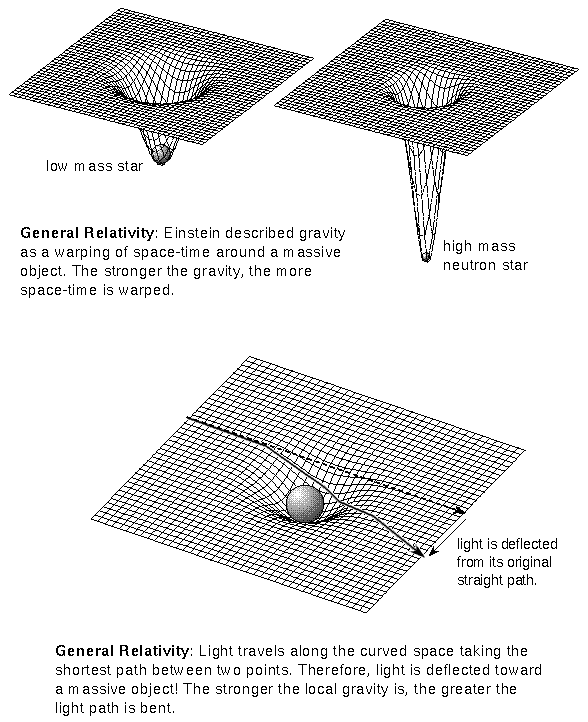
The example is best illustrated by imagining a horizontally flat bed sheet that is held tout. Think of this bed sheet as the fabric of spacetime. When it is empty, spacetime is flat. When you place small things on this flat fabric, they stay where they are – there is no gravity. Next, imagine placing a bowling ball on the fabric. Notice how the bowling ball changes the shape of the fabric so that now, if you place small things on the fabric, they ‘gravitate’ towards the bowling ball – the bowling ball pulls the small objects toward it, which is basically what gravity is all about!
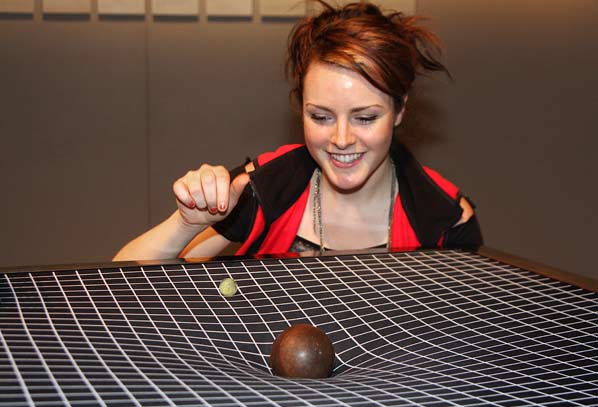
Now, Off To Black Holes!
Now that we know what gravity is (it’s the curvature of spacetime) and that it gets stronger as objects become more massive, we are almost ready to study the requirements that we must pass to become a full fledged black hole. But before we do, let us first look at some of the distinguishing characteristics of black holes.
When one fellow going by the name Karl Schwarzschild tried to solve Einstein’s equations, he noted that one solution described an object with very peculiar properties. One of the more amazing properties of this object is that it had a gravitational force so strong you need to travel faster than light just to escape its pull. But remember that nothing can go faster than light. Not even light could go faster than light! This means that when something gets too close to this object, they get sucked in and there is no escaping. Not even light can escape it! For this reason, such hypothetical object came to be called ‘black holes’. They’re called ‘black’ because they suck even light. And they are the universe’s biggest suckers! They suck everything from subatomic particles to stars.
The Standard Procedure
We are now ready to answer the question: how does one become a black hole? Well, here’s how.
1. Be a star. And don’t be just any star, but be a really massive one. A star like our Sun won’t do. To be safe, be a star that is around 20 times more massive than our Sun.
2. Die. Living stars are happily glowing orbs of plasma. That’s not what we want to be. We want to be black holes, and to be one you must be a dead star.
3. Furthermore, aspiring black holes like ourselves must follow the proper procedures when dying, which are listed as follows:
a. When you’re old, be a red supergiant. Red supergiants are among the biggest stars in the universe.
b. After becoming a supergiant, be a supernova. Supernovae are really bright explosions; they occur when a massive star reaches the end of its life. How many stars are there in a typical galaxy? Around billions. Even if you combine the brightness of all of these stars, a supernova is brighter still.
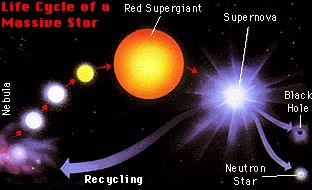
c. Don’t be a neutron star. Many big stars retire to become neutron stars. But neutron stars don’t suck. Instead, they are just very dense (like most people). In fact, neutron stars can be so dense that a glass full of neutron star can be heavier than a skyscraper!
d. If you followed procedures a, b and c when dying, then congratulations, you are now a black hole! Go suck away at the universe.
The Short Cut
Let’s face it, not all of us can be stars. Luckily, there’s a short cut one can follow to be a black hole. Even better, it can be expressed in one sentence.
Be very, very dense.
But recall that density is a measure of how compact an object is. To be dense is to have a lot of mass packed in a very small volume. Mathematically, density is mass divided by volume.
To be as dense as a black hole, you must do either of the following:
1. Be really massive. However, you must do this without getting bigger. If you gain as much volume as mass, that won’t increase your density. How massive? If you are a person 5’ 7” tall, you must increase your mass to 1.6 million billion billion kilograms. That’s about 27 times the mass of the Earth. Good luck with that!
2. Here’s another option: compress yourself to a very small ball. For a person who masses 55.0 kg, you’ll be a black hole if you are compressed to a ball of radius 0.000000000000000000000000082 meters. That’s actually a lot smaller than a hydrogen atom. Again, good luck with that.
3. The easiest way to be a black hole is to be massive and small at the same time. Consider the Earth. It’s a pretty massive thing, isn’t it? Well, to make it a black hole, you simply have to compress it to a ball with radius 8.8 millimeters. The radius 8.8 millimeters is called the Schwarzschild radius of the Earth. If you compress anything to a ball the size of its Schwarzschild radius, it becomes a singularity – in other words, a black hole. The Schwarzschild radius of a 55-kg person is 0.000000000000000000000000082 meters while that of the Sun is about 3 kilometers.
Additional Guidelines
Here are additional guidelines on how to be a happy, sucky black hole.
1. Rip space and time. Black holes are singularities. Singularities are regions in space and time where the curvature of spacetime becomes infinite. Using our fabric analogy earlier, black holes are regions where the fabric of space and time has a rip.
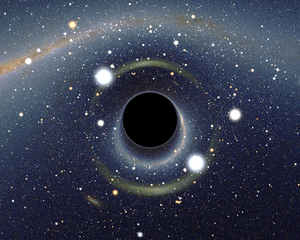
2. Don’t be naked. There is a hypothesis called ‘Cosmic Censorship’ that says that naked singularities don’t exist (with the possible exception of the Big Bang singularity, which partly explains its name). Singularities, according to this hypothesis, are always “concealed” by an event horizon, so that they are not visible to the rest of the universe. The event horizon of a black hole is the “surface of no return.” Since nothing that goes through the event horizon ever goes out, this means that anything that happens inside the event horizon will remain unknown to the rest of the universe.
3. Be hairless; black holes have no hair. What this means is that black holes have very few features. To describe a black hole, you just need to know its mass, its electric charge and how fast it rotates. If you have two black holes with the same mass, electric charge and speed of rotation, then you have no way to distinguish one from the other.
4. Be very disorderly. In physics, disorder is measured by a quantity called entropy. A very messy room has a high entropy while an organized room has low entropy. According to a principle called the Second Law of Thermodynamics, the entropy of an isolated system has a very strong tendency to increase with time. That is why you have to exert a lot of effort to keep you room neat and tidy but you don’t need to exert any effort at all to put it in disarray. Now, black holes are known to have very high entropy. As a matter of fact, they’re among the most disorderly things in the universe!
How do we know that black holes are very disorderly? It has something to do with the fact that disorderly systems are easy to describe. For example, how do you make a disorderly room? Just throw stuff around the place! How do you stack a random deck of cards? Just place any card on top of another without fussing which card is which. Orderly systems, on the other hand, are really difficult to describe. How do you fix a room to make it orderly? You have to put everything in its right place — the couch goes here, the table goes there, this painting is to be hanged here, and so on. How do you stack a deck where the cards arranged in increasing order? You have to put the aces first, then the ones next, then the twos after them, and so on.
Now, remember that black holes are hairless, which means that black holes are really easy to describe, which means they are very disorderly.
Happy Sucking!
So there, your very own guide to be a major sucker. I hope that helped a lot in your aspirations to be one of the universe’s most curious objects. Now it’s time for you to go away from me — I don’t want to be sucked in just yet.
Photo credits:
- ffden-2.phys.uaf.edu
- cse.ssl.berkeley.edu
- astronomynotes.com
- imagine.gsfc.nasa.gov
- eastpdxnews.com
- blogs-images.forbes.com

